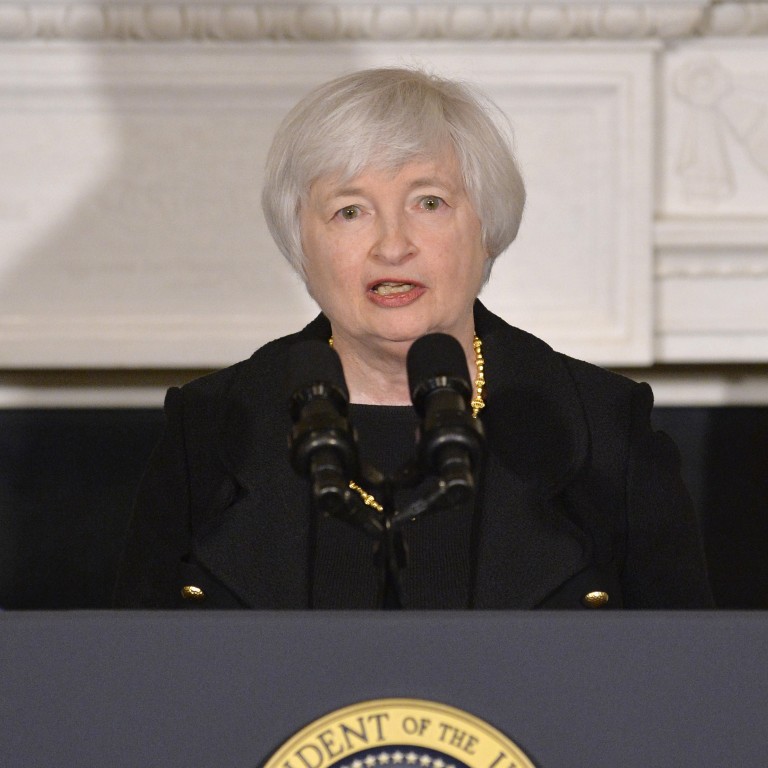
Incoming Fed chief will face hard task of withdrawing crisis medicine
Andrew Sheng says Janet Yellen will need to wean markets and governments off low interest rates
In Chinese history, a woman's ascension to power is either a sign of profound change or dramatic crisis. Janet Yellen's nomination to assume chairmanship of the US Federal Reserve is a sign of changing times. Note that both the Fed and the US Securities and Exchange Commission will be headed by women. After all, Christine Lagarde, head of the International Monetary Fund, has said that if Lehman Brothers had been a bit more "Lehman Sisters", we would not have had the same degree of tragedy.
In essence, we need women to clean up man-made messes.
The difference here is that Yellen is not taking over in crisis, but she is faced with withdrawing the medicine for the crisis. She inherits an intoxicated punch bowl, with a central bank that needs to unwind massive quantitative easing, at the same time as the US faces its own debt debacle.
Her nomination is a sign of changing times ... we need women to clean up man-made messes
The rest of the world is aghast that the most powerful economy in the world can have a debate on whether the government will stop paying its bills, because some "tea party" members are playing a game of "who blinks first" with the president on changing health-care legislation.
I have no doubt that in terms of IQ, EQ and experience, Yellen is eminently qualified to be the captain of the world's leading central bank. As a former president of the San Francisco Fed, she understands not only the issues of an open, innovative West Coast economy, but also the dynamic Pacific Rim countries that account for 55 per cent of world gross domestic product.
The economies of the Asia-Pacific Economic Co-operation forum, being large users of the dollar for trade and the largest dollar holders in their foreign exchange reserves, have high hopes that the new Fed chairwoman will protect the value of their dollar holdings.
What is the scorecard that Yellen has inherited? The latest round of quantitative easing involves the purchase of US$85 billion worth of long-term Treasury paper per month, for as long as it is necessary. Furthermore, since December 2012, the Fed has said it intends to hold the federal funds rate near zero, until unemployment has declined below 6.5 per cent.
As far as I know, there is no theoretically proven effect of low interest rates reversing the level of unemployment. Despite this, the purpose of quantitative easing is to tell Congress that the Fed stands fully behind the economy, buying time for politicians to undertake real structural reforms.
But that is exactly the unfortunate dilemma of modern central banking. By stepping forward with a printing solution in a policy vacuum, central banks gave their politicians the perfect excuse not to take the tough medicine of structural reforms.
As Luxembourg Prime Minister Jean-Claude Juncker honestly admitted: "We heads of government all know what to do, we just don't know how to get re-elected when we do it."
Unconventional times needed unconventional tools. The Fed can be congratulated for taking decisive action in 2008 to prevent a financial meltdown. But applying a stimulant once, during a heart attack, does not mean that you should apply it forever.
There are several good reasons why aggressive and prolonged easing can lead to negative results. First, by spraying everyone with liquidity, it is the banks and those able to borrow cheaply who benefit more than those who cannot access finance. This is a distributional issue that has huge political ramifications that will haunt future central bank independence.
Second, the low interest rates actually erode the income of pension funds and life insurance companies, thus worsening the net wealth of retirees - another distributional issue that explains why Republicans do not like quantitative easing.
Third, prolonged low interest rates and high liquidity renewed incentives for a "search for yield" and another round of speculation and leveraging. Large carry trade capital flows rushed into emerging markets, and there was a huge gush out in May when Ben Bernanke started hinting about tapering the asset buying.
Fourth, quantitative easing and low interest rates are atrophying market discipline. Central bank balance sheets are triple what they were before 2007. They have become frontline intermediaries in areas such as the mortgage market and money markets.
Indeed, governments with debt over 100 per cent of GDP are completely reliant on low interest rates to sustain their budget debt servicing at a reasonable level.
The financial markets and governments are very happy that Yellen said in April she is persuaded that "the policy rate should, under present conditions, be held 'lower for longer' than conventional policy rules imply", suggesting that she is a monetary dove.
But what may be needed is tough action to ensure that the US and the rest of the world do not enter a period of stagflation - slow growth, high unemployment and inflation.
Now that's a real test of central banking skills. Good luck, Janet. We all wish you well.

